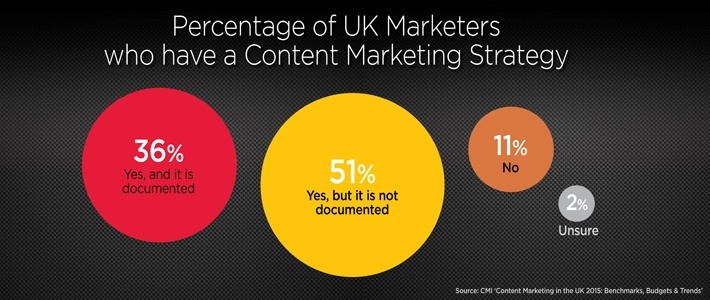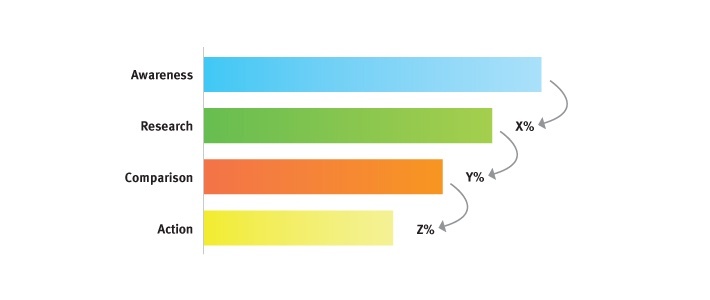2014 saw content marketing established as central to B2B marketing plans. We analyse the key trends and offer thoughts on the evolution of B2B content marketing in 2015.
As the latest industry reports and surveys show, content creation and distribution is at an all-time high and marketing budgets are being allocated accordingly. But there are still many areas where B2B marketers can improve.
1. B2B content strategy comes to the fore
More B2B marketers are recognising the importance of a formal content marketing strategy to focus their activity. According to a recent CMI research report, a documented content marketing strategy dramatically improves the effectiveness of a company’s efforts. In 2014, 48% of UK marketers said they were effective, but that figure rises to 71% for those who said they had a documented strategy.
We say: A documented content marketing strategy means marketers can plan campaigns in line with a broader outlook of business development objectives, create more targeted content, stick to a distribution plan and measure ROI more effectively. If it’s not written down, you don’t have a strategy.

2. B2B firms develop a content culture
Rather than creating content on a campaign basis, content marketing will form the core of marketing strategy, promoting a culture of content. Marketing departments will need to work closely to create consistent campaigns that work across platforms – from print and email to websites and social media.
"Brands will recognize the role of editor as the missing link to true content marketing effectiveness. We’ve figured out how to create content and how to publish, but can’t move firmly into brand journalism until we adopt an editorial discipline." Sarah Mitchell, head of content strategy, Lush (60 content marketing predictions for 2015)
We say: B2B firms have some way to go in this regard. A recent Forrester Research report found that in 72% of B2B marketing teams, less than half of the staff played a primary role in content marketing activity. But delivering a consistent, coherent message that is channel- and format-neutral requires much more than just hiring people with the right technical abilities. A culture of content will only succeed if that content is fully attuned to client needs. And that requires a change in mindset. What clients want – insights around their most pressing business issues – and what B2B firms tend to deliver – information on their latest products and services – are two different things.
3. B2B will be knee-deep in content
78% of UK marketers say they will be creating more content in 2015. As communications with clients become increasingly real-time, content length will decrease to cater to the time-constrained audience, making content easily digestible as well as more shareable.
We say: The quantity may increase, but will the quality? Engagement remains the number one challenge for B2B marketers: we often see B2B firms expending time and effort in developing long-form content around key topics, distributing it once, and wondering why it doesn’t stick. Marketers should be wary of sacrificing quality for volume but shorter-form content offers a definite opportunity. Maximising awareness and value through quality supporting material (particularly visual) to promote the constituent parts will deliver an increase in volume as well as engagement.
4. B2B brands embrace storytelling
Case studies are already a popular format in B2B but in 2015 marketers will look for new ways to involve clients and associates in telling their stories.
“If you want your content to be great, get your customers to participate. The value of co-creating content with the very audience you want to do business with is very powerful.” – Lee Odden, CEO, TopRank (60 content marketing predictions for 2015)
“The content marketing trend will reach corporate communication, starting with CSR. It’s a great source of engaging stories, and companies are used to telling them.” – Joakim Arhammar, content strategist, Comprend (60 content marketing predictions for 2015)
We say: B2B firms have a wealth of content at their disposal in the form of client stories. Typically case studies follow a formulaic approach, which can bore readers/viewers quickly and lose impact. Involving clients in exploring issues and solutions adds more personal appeal to your content, and can take the form of interviews, guest blogs, events or video.
In the same way, B2B firms are sometimes reticent about talking about their CSR activities. But this rich vein of human interest stories can be used to engage staff, stakeholders and the wider community.

5. Print becomes the B2B disruptor
Although, here at Grist, we still receive a strong demand for the creation of print client magazines, overall the spotlight has been focused on digital marketing tactics in the last few years. We are therefore pleased that the power of print and its increasing competitive advantage in a digital world has been recognised by the CMI's Joe Pulizzi.
“We will see a surge in print magazines from brands in 2015. As most brands continue to focus heavily on digital, smart brands will realise that it is much easier to cut through the clutter by leveraging ‘the post’ – without much competition at all.” - Joe Pulizzi, founder, Content Marketing Institute (60 content marketing predictions for 2015)
We say: Print still has a significant role to play in B2B marketing, conveying an authority and delivering a wow factor that is hard to replicate online. Digital is rightly praised for its immediacy, usability and ease of measurement, but aligned to clear business objectives and success criteria, client publications encourage more time spent with your brand and can bring tangible results to the bottom line.
6. B2B marketers work longer hours
B2B firms will start to adapt their content offering to the new digital world of business where mobile and tablets dominate and executives are increasingly active on social media.
A 2014 CNBC survey found that 60% of business executives in Europe, the US and Asia access business content via their mobile device over the weekend. This was accompanied by a significant jump in social media use among European business executives to 97% in 2014, with LinkedIn usage rising 8% to 66%.
We say: Understanding the changing consumption habits of business audiences will help B2B marketers gain the upper hand on competitors. Content will need to be optimised for mobile and tablets, with responsive design becoming the norm. And when the new business primetime may be 10pm on a Sunday, marketers will have to wonder why they’re still restricting themselves to the nine-to-five.
7. B2B teams dig deeper into data
Measuring content effectiveness will be a top priority for B2B marketers in 2015. Only 28% say they are successful at tracking ROI at the moment. Marketers will want to know how to use data from websites and social media channels to gain deeper insights and there will be many more agencies that provide services to help in this regard.
We say: The desire to measure ROI is no surprise as B2B marketers seek long-term board-level buy-in for their content marketing investment. Rather than just counting web traffic and social shares, measuring ROI effectively means setting success criteria tied to defined business goals from the outset. It is, therefore, also no surprise that those who believe they are tracking ROI successfully rises to 46% among those with a documented content marketing strategy.

Final thoughts…
Making content marketing the engine of brand awareness is still a relatively new idea but the model is maturing at a fast pace. If content marketers can continue to adapt to the digital B2B landscape, they will not only survive, but thrive in 2015.
Marketers are in a strong position to use the new technologies to build relationships with prospective and current clients through delivering valuable information people actually need. As long as we are trying to communicate with humans, we will always need to tell a story that others will want to share.
“2015 will be the year that B2B content marketing comes of age. Those that formally align their content with the broader marketing strategy, and ensure that they meet clients’ needs as well as their own will prosper. Those that don’t will fall by the wayside.” – Andrew Rogerson, co-founder, Grist.


